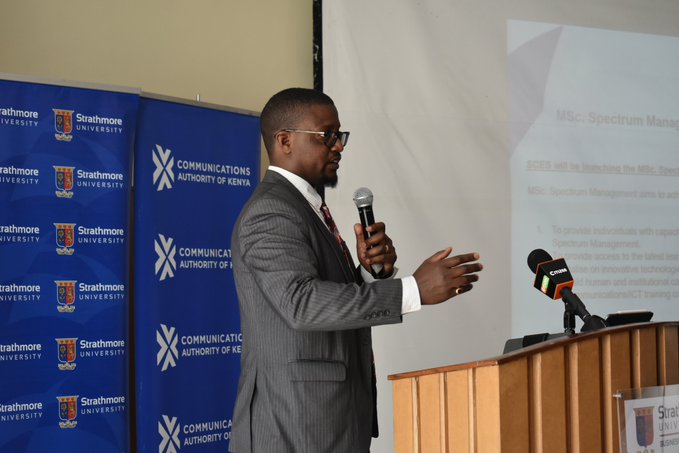@iLabAfrica – Strathmore University, in collaboration with the Dynamic Spectrum Alliance (DSA) under the Digital Access Program (DAP) sponsored by the Foreign, Commonwealth, and Development Office (FCDO), has handed over three (3) reports on the study of Enhancing Affordable Broadband Connectivity through Dynamic Access to Spectrum (DSA) to the Communications Authority of Kenya (CA).
Speaking during the event, @iLabAfrica Director, Dr. Joseph Sevilla mentioned, ” As much as we are achieving new landmarks, we want to make sure that everyone in Kenya gets access to internet connectivity, especially in the rural areas and we hope that this study will help us get there.”
“Radio Frequency (RF) spectrum is the lifeblood of delivering communication and Internet services, not only in Kenya but across the globe. There is a need to explore more innovative ways to enable efficient access to the RF spectrum and enable more affordable Internet access to the underserved groups. One such innovative way is through Spectrum Sharing.” Leonard Mabele- Manager, Internet of Things (IoT) and Wireless Networks at @iLabAfrica- Strathmore University.
One of the reports addressed the existing gaps in spectrum sharing in Kenya and gave recommendations on how the Communications Authority (CA) can enable the use of unutilized Radio Frequency (RF) spectrum to deliver broadband connectivity to communities that currently have poor Internet connectivity.
The other two (2) reports were on engagement with stakeholders and technical findings on Co-existence between the incumbents (Fixed Services and Fixed Satellite Services) and Wi-Fi 6E in the 6 GHz band. The Stakeholder engagement report presented metrics on the level of understanding among various stakeholders and their interpretation of the shared spectrum frameworks.
Earlier studies conducted in Kenya by @iLabAfrica – Strathmore University and CA in 2020, showed that counties such as Kisumu, Kitui, and Laikipia, had significant populations lacking connectivity to the Internet due to challenges of low income and longer distances from core networks such as Fiber. Conversely, the studies discovered unutilized frequencies in the broadcasting spectrum that could be exploited to provide affordable wireless connectivity to those counties.
Television White Spaces (TVWS) was the first shared spectrum network across the world that allowed Internet services to coexist with broadcasting services in the same RF band. The migration of analogue TV to digital TV broadcasting opened up unused TV frequencies that could be leveraged to provide internet services. These unused TV frequencies are what we refer to as TV White Spaces.
With Wi-Fi’s economic value projected to grow to US $4.9 trillion by 2025 – as predicted by the Wi-Fi Alliance (WFA) – Wi-Fi 6E (Wi-Fi in the 6 GHz band), the focus of the third report, presents an opportunity for more efficient Wi-Fi access with enhanced bandwidth and capacity for the country while coexisting with the incumbent services. This is postulated to meet the growing demand for quality Wi-Fi access especially with the increasing number of wireless devices and Internet of Things (IoT) deployments. Until now, Wi-Fi has been known to operate in the 2.4 GHz and 5 GHz bands – both of which have limitations in terms of congestion and available bandwidth.
“If good spectrum decisions are in place, then we can see an impact on digital connectivity and the growth of the digital ecosystem” stated Martha Suarez, President of the Digital Access Program.
This project was funded to contribute to efficient RF spectrum usage and internet access initiatives in Kenya through Spectrum Sharing.

